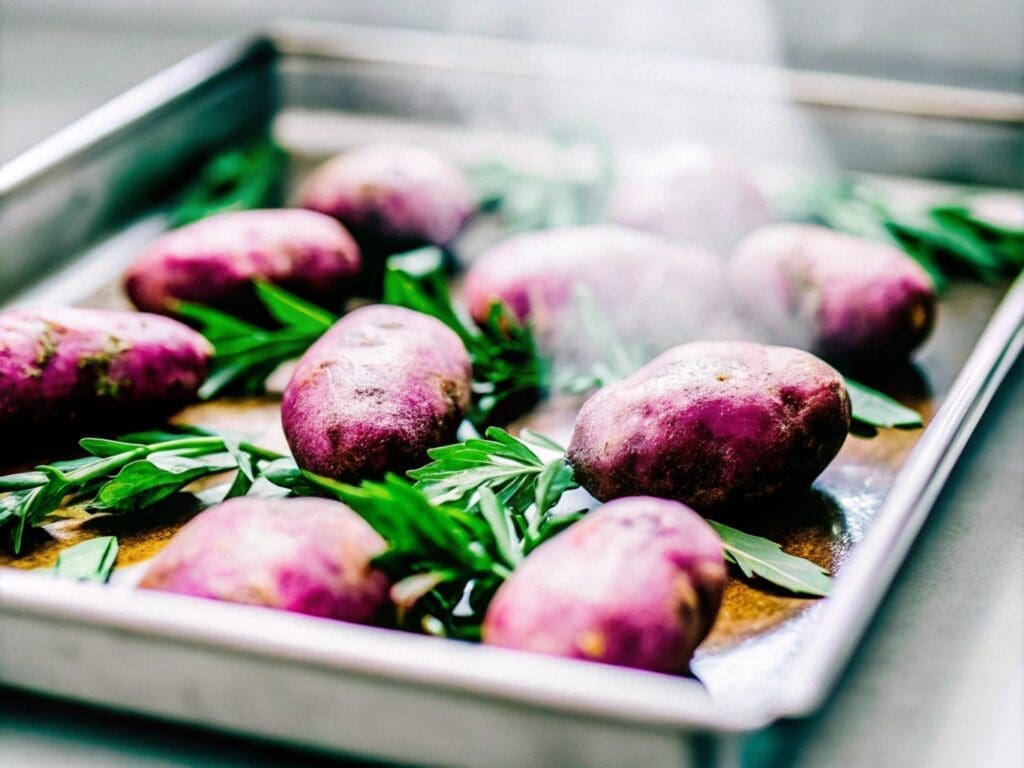Have you ever wondered, Do purple sweet potatoes taste different? Their vibrant color makes them a star ingredient in many dishes, but it’s their unique flavor profile that leaves people curious. While all sweet potatoes have a naturally sweet taste, purple sweet potatoes offer a distinct experience that sets them apart from their orange and white counterparts.
In this article, we’ll explore the taste of purple sweet potatoes, how they compare to other varieties, and why they’ve gained popularity in kitchens worldwide. Let’s dive into the world of purple sweet potatoes and discover what makes their flavor truly unique.
Ingredients of Purple Sweet Potatoes
Purple sweet potatoes are not just visually appealing; their taste is influenced by the unique compounds they contain. While this section doesn’t list traditional ingredients like a recipe, it breaks down the elements that contribute to their flavor profile.
| Component | Role in Taste |
|---|---|
| Natural Sugars | Provide a mild, earthy sweetness, subtler than orange sweet potatoes. |
| Anthocyanins | Responsible for the purple color and add subtle floral notes. |
| Starch Content | Creates a denser, drier texture compared to other varieties. |
| Moisture Level | Lower moisture contributes to their firmer bite. |
Substitutions and Comparisons
If you’re used to the creamy sweetness of orange sweet potatoes, purple sweet potatoes may surprise you. They’re less sugary and have a more complex, nutty undertone. Substituting purple sweet potatoes for other types in recipes will impact the dish’s texture and flavor, making it slightly less sweet but more aromatic.
When choosing purple sweet potatoes, keep in mind that there are two common varieties:
- Okinawan Purple Sweet Potatoes: Earthy and rich in flavor with moderate sweetness.
- Stokes Purple Sweet Potatoes: Slightly sweeter and more moist, often favored for baking.
Instructions: Cooking and Tasting Purple Sweet Potatoes
To truly appreciate the flavor of purple sweet potatoes, it’s essential to prepare them correctly. Below is a step-by-step guide to cooking them in various ways that highlight their unique taste.
1. Baking
Baking purple sweet potatoes is one of the best ways to bring out their natural sweetness and earthy undertones.
Instructions:
- Preheat your oven to 375°F (190°C).
- Wash the sweet potatoes thoroughly and pat them dry.
- Pierce each potato with a fork several times to allow steam to escape.
- Place them on a baking sheet and bake for 60–70 minutes, depending on their size.
- Remove from the oven, let them cool slightly, and enjoy their rich, nutty flavor.

2. Steaming
Steaming preserves the vibrant color and nutrients of purple sweet potatoes while giving them a softer texture.
Instructions:
- Peel and cut the sweet potatoes into chunks.
- Place a steamer basket in a pot with 1-2 inches of water.
- Add the sweet potatoes to the basket, cover, and steam over medium heat for 15–20 minutes.
- Test for doneness with a fork; they should be tender but not mushy.
Steamed purple sweet potatoes pair well with a drizzle of honey or a sprinkle of cinnamon to enhance their subtle sweetness. For more antioxidant-rich meal ideas, explore our quick carrot juice energy detox to complement your healthy diet.
3. Mashing
If you enjoy mashed potatoes, purple sweet potatoes add a colorful twist with a unique flavor profile.
Instructions:
- Steam or boil peeled sweet potatoes until tender.
- Mash them with a fork or potato masher.
- Add butter, milk, and a pinch of salt to taste.
- For a sweeter option, mix in a tablespoon of maple syrup or coconut sugar.

4. Roasting
Roasting purple sweet potatoes enhances their nutty, caramelized flavor.
Instructions:
- Preheat your oven to 400°F (200°C).
- Cut the sweet potatoes into wedges or cubes.
- Toss with olive oil, salt, pepper, and your choice of seasonings (e.g., paprika or rosemary).
- Spread them evenly on a baking sheet and roast for 25–30 minutes, flipping halfway through.

Tasting Tips
- Raw Flavor Test: Taste a small slice raw to experience its subtle sweetness and firm texture.
- Pairings: Purple sweet potatoes complement savory flavors like garlic and herbs or sweet accents like coconut milk and honey.
Cultural and Historical Context of Purple Sweet Potatoes
Purple sweet potatoes have a fascinating history that spans across continents and cultures. Their vibrant color and unique taste make them a prized ingredient in both traditional and modern cuisines.
Origins and Spread
Purple sweet potatoes are believed to have originated in Central and South America, like other sweet potato varieties. However, they gained prominence in Asia, particularly in Okinawa, Japan, where they are a dietary staple. Today, they are grown worldwide, from Hawaii to the Philippines, with distinct varieties emerging based on local cultivation techniques.
In Okinawa, purple sweet potatoes, known as beni imo, are central to the island’s renowned longevity diet. Their rich anthocyanin content provides antioxidants that contribute to health and vitality.
Symbolism and Use in Festivities
In many cultures, purple foods are associated with royalty, prosperity, and creativity. The striking hue of purple sweet potatoes makes them a popular choice for celebratory dishes:
- Japan: Used in desserts like mochi and tarts, their subtle sweetness and vivid color enhance traditional confections.
- Hawaii: Featured in pies and poi, purple sweet potatoes are a key ingredient in Hawaiian cuisine.
- Philippines: Incorporated into festive treats like ube halaya and ube cake, their flavor is beloved in Filipino desserts.
Modern Culinary Trends
With the rise of plant-based diets and Instagram-worthy meals, purple sweet potatoes have become a trendy ingredient. Their natural color adds visual appeal to dishes, while their distinct taste offers versatility in both sweet and savory recipes. For a savory dish that’s as visually appealing as it is delicious, try our steak quesadilla recipe that pairs perfectly with vibrant sides.
Interesting Fact: Unlike artificially colored foods, the purple hue of these sweet potatoes is entirely natural and derived from anthocyanins, which are also found in blueberries and red cabbage.
Creative Variations and Customizations
One of the best things about purple sweet potatoes is their versatility. Whether you’re looking for a sweet dessert or a savory dish, these vibrant tubers can adapt to any culinary idea. Let’s explore some creative ways to enjoy them.
1. Sweet Treats
Purple sweet potatoes shine in desserts, thanks to their mild sweetness and striking color.
- Purple Sweet Potato Cheesecake: Blend mashed purple sweet potatoes into a creamy cheesecake mixture for a naturally purple dessert.
- Ube Ice Cream: Whip up a batch of this Filipino favorite by combining cooked purple sweet potatoes with coconut milk, sugar, and vanilla.
- Purple Sweet Potato Pie: A colorful twist on the classic sweet potato pie, perfect for holidays or special occasions.
Tip: Add a touch of cinnamon or nutmeg to accentuate their natural sweetness in desserts. For more easy and irresistible ideas, explore our puff pastry dessert recipes that are sure to delight.
2. Savory Dishes
For savory meals, purple sweet potatoes bring a nutty depth and beautiful color.
- Purple Sweet Potato Gnocchi: Combine mashed purple sweet potatoes with flour and egg to create a vibrant, pillowy pasta.
- Casseroles: Layer roasted slices with cheese, cream, and herbs for a visually stunning gratin.
- Purple Sweet Potato Fries: Cut into sticks, toss with oil and spices, and bake until crispy for a healthier fry option.
3. International Inspirations
Draw from global cuisines for exciting ways to cook with purple sweet potatoes:
- Japanese Tempura: Coat slices of purple sweet potato in a light batter and fry until crisp.
- Hawaiian Poi: Mash steamed purple sweet potatoes with a splash of water to create a smooth, starchy side dish.
- Caribbean Stews: Add chunks of purple sweet potatoes to hearty stews for a burst of color and flavor.

4. Dietary Modifications
Purple sweet potatoes are naturally gluten-free, vegan, and nutrient-rich, making them ideal for various dietary needs. Here are some ideas:
- Low-Sugar Desserts: Use purple sweet potatoes as a natural sweetener in cakes or cookies.
- Keto-Friendly Swaps: Combine small amounts of purple sweet potato with cauliflower to create a lower-carb mash.
- Allergy-Friendly Snacks: Bake purple sweet potato chips for a crunchy, allergen-free alternative to potato chips.
Pro Tip for Color Retention
To keep the vivid purple hue intact, cook purple sweet potatoes with minimal water or steam them instead of boiling. Their color is sensitive to pH, so avoid adding acidic ingredients like vinegar during cooking.
FAQs About Purple Sweet Potatoes
To fully appreciate these vibrant tubers, let’s address some of the most common questions people have about purple sweet potatoes.
1. Do purple sweet potatoes taste different from orange ones?
Yes, purple sweet potatoes have a distinct taste compared to orange sweet potatoes. While orange sweet potatoes are sweeter and have a creamier texture, purple sweet potatoes are less sweet with a denser, drier texture. Their flavor has earthy and nutty undertones, often described as slightly floral.
2. Can I use purple sweet potatoes in the same recipes as regular sweet potatoes?
You can substitute purple sweet potatoes in most recipes, but the results will differ. Their lower moisture content and firmer texture might require adjustments, such as adding extra liquid in mashed dishes or longer cooking times when baking.
3. Are purple sweet potatoes healthier than other varieties?
Purple sweet potatoes are packed with anthocyanins, antioxidants that help fight inflammation and promote heart health. They’re also rich in fiber, vitamins A and C, and potassium. While all sweet potatoes are healthy, the unique compounds in purple ones make them a particularly nutritious choice.
4. How can I tell if a purple sweet potato is ripe?
Purple sweet potatoes should feel firm and have smooth, unblemished skin. The color of their skin may range from light tan to deep purple, depending on the variety. Unlike some fruits, sweet potatoes don’t ripen after harvesting, so choose ones that are ready to use.
5. What are the best storage tips for purple sweet potatoes?
Store purple sweet potatoes in a cool, dark, and dry place, such as a pantry or cellar. Avoid refrigerating them, as cold temperatures can alter their texture and flavor. They’ll stay fresh for several weeks when stored properly.
Conclusion
So, do purple sweet potatoes taste different? The answer is a resounding yes! With their nutty, earthy undertones and slightly floral sweetness, purple sweet potatoes offer a flavor experience that stands apart from their orange and white counterparts. Their vibrant color, dense texture, and unique taste make them a versatile ingredient, perfect for everything from sweet desserts to savory main dishes.
Whether you’re experimenting with traditional recipes or creating something entirely new, purple sweet potatoes can add a burst of color and nutrition to your meals. With their cultural significance and modern appeal, they are more than just a trend—they’re a culinary treasure.
Why not give them a try? Bake, mash, roast, or steam them to discover their delicious potential. Once you do, you’ll likely find them becoming a staple in your kitchen. For step-by-step guidance, check out our detailed guide on how to make the best purple sweet potato recipe to elevate your culinary creations.
If you enjoyed this article, be sure to explore our other recipe ideas and tips for cooking with sweet potatoes. Let us know your favorite way to enjoy purple sweet potatoes in the comments below!



Comments are closed.